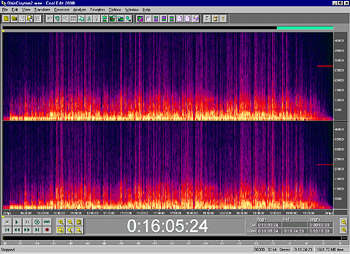| Columns Retired Columns & Blogs |
What's Going On Up There? Page 2
As might seem obvious, much of this energy is due to the drummer's cymbals, particularly his ride cymbal, which had an HF-intensive ping/hiss character. However, at 7:30 the drummer stops playing and Jimmy D. solos for a few minutes on his Fender Stratocaster. You can still see spectral content well above 22kHz—even though the guitar amp uses 12" drive-units with an atrocious HF response, and the microphone used was (if I remember correctly) a moving-coil Shure SM57. The sound of the electric blues guitar depends greatly on the partnering amplifier being driven heavily into clipping; I assume that what this graph reveals is the fact that the squared-off waveform of the amplified blues guitar produces odd-order harmonics extending way above the nominal audioband. If you want to accurately record all the spectral components of Jimmy D.'s guitar and amplifier—ie, the waveform listeners would have been exposed to in real life—you need to use at least an 88.2kHz sample rate.
Footnote 3: Message 3987BAB7.169DB36C@mailbox.bellatlantic.net, posted August 2, 2000.
One argument that has been going on for the past 20 years is about how the venerable LP compares to the bandwidth-limited CD medium in this respect. Yes, you can press spectral energy onto an LP extending an octave or so above the cutoff frequency of 44.1kHz-sampled digital—the JVC CD-4 quadraphonic system of the 1970s used a subcarrier frequency above 30kHz—but a typical moving-magnet cartridge doesn't have a sufficiently wide bandwidth to recover it.
Erstwhile Audio editor Michael Riggs recently expressed on the rec.audio.high-end newsgroup (footnote 3) his skepticism about the ability of the LP medium to record and reproduce content above 20kHz: "I don't think the range from 20 to 30kHz bears much on [the difference between the information capacities of LP and CD], for two reasons: (1) It is difficult to get such information onto an LP and even harder to retrieve it accurately. And even if it is pressed into a disc, it probably will be wiped off it after a few plays [and] (2) You're talking about a half octave in a range where most people are deaf and where little music contains appreciable energy."
But with its much lower tip mass and its low inductance, a moving-coil pickup does pick up such information. So, as I am using the CardDeluxe to archive commercial recordings I had played on from the 1960s and 1970s, I reproduce a spectrogram (fig.5) that shows a few minutes from an inner-groove track, "Sign of the Times," on an LP (Obie Clayton, DJM DJLPS 458) my band released in 1975. This was recorded at 15ips on a 16-track 3M analog machine using Dolby-A noise reduction and mastered for the LP release by the famed George "Porky" Peckham. (Scratched into the leadout area is his trademark, "A Porky Prime Cut.") For LP playback, I used a Linn Arkiv 2 MC phono cartridge, amplified by a Linn Linto phono stage and Mark Levinson No.380S line preamplifier to feed the Apogee PSX-100 A/D converter (reviewed in the June 2000 Stereophile by Michael Fremer).

Fig.5 Spectrogram of "Sign of the Times," from Obie Clayton (1975 LP), transcribed at 24 bits and 88.2kHz sample rate with Linn Arkiv 2 MC phono cartridge.
As far as I know—I was present during the mastering—George Peckham took no heroic measures to preserve the master tape's ultrasonic content, and this copy of the Obie Clayton album has been played many times. Yet you can see from fig.5 that the spectral content does extend out to 40kHz at regular intervals—again, almost all cymbals and electric guitar, with the exception of three of the many vertical red lines, which are due to clicks.
It might be argued that either a cutter-head resonance or the cartridge's tip-mass/vinyl-compliance ultrasonic resonance has amplified the recording's ultrasonic content, so it's possible that this spectrogram does not accurately represent the original master tape's high-frequency content. I don't know where the quarter-century-old tapes are, so I can't check this hypothesis. However, empirical evidence that neither were the case is that if the frequencies of such resonances were below the 44.1kHz cutoff frequency in this graph, you would see them as persistent horizontal colored lines. That no such lines are evident implies that the cutter-head resonance was well-damped and that the Arkiv's undamped tip-mass resonance was above 44.1kHz.
So, even if the bulk of musical energy exists below 10kHz, these spectrograms suggest that there is still recognizable content for almost an octave above the audioband. If you want to preserve waveform accuracy in your recording, you need to use a sample rate significantly higher than the CD's 44.1kHz or the DAT's 48kHz. Bob Stuart felt that a 64kHz sample rate would be sufficient. But as the energy in these recordings I have analyzed does extend higher than 32kHz, and using a power-of-two multiplier makes life easy for digital- and storage-media engineers, you might as well use 88.2kHz or 96kHz.
Footnote 3: Message 3987BAB7.169DB36C@mailbox.bellatlantic.net, posted August 2, 2000.
- Log in or register to post comments




































